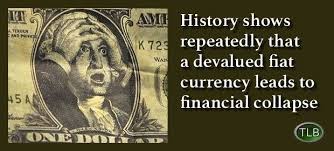Fiat money
Fiat money (like the U.S. Dollar) is printed legal tender by a government decree or fiat. It does not have intrinsic value. It has value only because a government maintains its value.
If you are selling your home, would you accept a bag of rocks as payment? That is what billions of people do every day. The only difference is they accept a little piece of paper called the U.S. Dollar or EURO or nearly 200 other currencies from other countries instead of the rocks. The dollar has value because of perception. The rock has no value because of perception. Before 1971 the U.S. Dollar was valued by Gold (another rock). So, the global economy and exchange rates between currencies rely on perception.
The U.S. Dollar is perceived as the strongest and most stable FIAT currency. But what would happen if the U.S. went into a deep recession or depression topped off with hyperinflation. Countries that have experienced economic collapses and hyperinflation find their citizens getting paid daily. They go out and buy bread and milk in the morning, knowing the next day that same loaf of bread or gallon of milk went up in price by 1000%. Money becomes worthless.
Now, all countries on earth use FIAT currency. If a large percentage of people went to their bank to withdraw their money, the system will collapse. In fact, it already did in 2008. So what do countries do, just print more money and issue a Treasury Bill to pay the loan back in the future?
There comes a time when the interest on all that Treasury Bill interest rate cant is paid. The country cannot generate enough tax revenue to pay just the interest on all its debt. When this happens, the economy collapses, and its currency becomes worthless. The U.S. is on the cusp of being in that position.
Fiat money is a government-issued currency that is not backed by a commodity such as gold. Fiat money gives central banks greater control over the economy because they can control how much money is printed. Most modern paper currencies, such as the U.S. dollar, are fiat currencies.
What is Fiat Money?
Fiat money is a currency that lacks intrinsic value and is established as a legal tender by government regulation. Traditionally, currencies were backed by physical commodities such as silver and gold, but fiat money is based on the creditworthiness of the issuing government.
The value of fiat money depends on supply and demand and was introduced as an alternative to commodity money and representative money. Commodity money is created from precious metals such as gold and silver, while representative money represents a claim on a commodity that can be redeemed.
China was the first country to use fiat currency, around 1000 AD, and the currency then spread to other countries in the world. It became popular in the 20th century when U.S. President Richard Nixon introduced a law that canceled, the direct convertibility of the U.S. dollar into gold. Currently, most nations use paper-based fiat currencies that only serve as a mode of payment.
Unlike the traditional commodity-backed currencies, fiat currency cannot be converted or redeemed. It is intrinsically valueless and used by government decree. For a fiat currency to be successful, the government must protect it against counterfeiting and manage the money supply responsibly.
History of Fiat Money
Fiat money originated from China in the 10th century, mainly in the Yuan, Tang, Song, and Ming dynasties. In the Tang Dynasty (618-907), there was a high demand for metallic currency that exceeded the supply of precious metals. The people were familiar with the use of credit notes, and they readily accepted pieces of paper or paper drafts.
A shortage of coins forced people to change from coins to notes. During the Song Dynasty (960-1276), there was a booming business in the Sichuan region that led to a shortage of copper money. Traders started issuing private notes covered by a monetary reserve, and it was considered to be the first legal tender. Paper money became the only legal tender in the Yuan Dynasty (1276-1367), and issuing of notes was conferred to the Ministry of Finance during the Ming Dynasty (1368-1644).
The West started using paper money in the 18th century. American colonies, France, and the Continental Congress started issuing bills of credit that were used to make payments. The provincial governments issued notes that the holders would use to pay taxes to the authorities. The issuing of too many bills of credit generated some controversy due to the dangers of inflation.
In some regions, such as New England and the Carolinas, the bills depreciated significantly and there was a hike in commodity prices as the bills lost value. During wars, countries turn to fiat currencies to preserve the value of precious metals such as gold and silver. For example, the Federal Government of the United States turned to a form of fiat currency referred to as “Greenbacks” during the American Civil War. The government halted the convertibility of its paper money to gold or silver during this war.
In the early 20th century, the government and banks had promised to allow the conversion of notes and coins into their nominal commodity on demand. However, the high cost of the American Civil War and the need to rebuild the economy forced the government to cancel the redemption.
The Bretton Woods Agreement fixed the value of one troy ounce of gold to 35 United States Dollars. However, in 1971, United States President, Richard Nixon, introduced a series of economic measures including canceling the direct convertibility of dollars into gold due to declining gold reserves. Since then, most countries have adopted fiat monies that are exchangeable between major currencies.
How Does Fiat Money Work
Fiat currency is not supported by any physical commodity, but by the faith of its holders and virtue of a government declaration. Paper money acts as a storage medium for purchasing power and an alternative to the barter system. It allows people to buy products and services as they need without having to trade products for products, as was the case with barter trade.
Due to its ability to store purchasing power, people can make plans with ease and create specialized economic activities. For example, a business dealing with mobile phone assembly can buy new equipment, hire and pay employees, and expand into other regions.
The value of fiat money is dependent on how a country’s economy is performing, how the country is governing itself, and the effects of these factors on interest rates. A country experiencing political instability is likely to have a weakened currency and inflated commodity prices, making it hard for people to buy products as they may need.
A fiat currency functions well when the public has enough confidence in the currency’s ability to act as a storage medium for purchasing power. Also, it must be backed by the full credit of the government that gives a decree and prints it as a legal tender for financial transactions.
Advantages and Disadvantages of Fiat Currency
The most important feature of fiat money is the stability of its value, unlike commodity-based money like gold, copper, and silver. The use of fiat money became popular in the 20th century as governments and banks moved in to protect their economies from the frequent busts of the business cycle.
Commodity-based currencies were volatile due to the regular business cycle and periodic recessions. The central banks can print or hold paper money as they may need, giving them greater control over the money supply, interest rates, and liquidity. For example, the Federal Reserve’s control over the money supply and demand enabled it to manage the Global Financial Crisis of 2008 from causing greater harm to the U.S. financial system and global economy.
Although fiat money is viewed as a more stable currency that can cushion against recessions, the global financial crisis proved otherwise. Even though the Federal Reserve controls the money supply, it was not able to prevent the crisis from happening. Critics of fiat money argue that the limited supply of gold makes it a more stable currency than fiat money, which has an unlimited supply.
Fiat money
Welcome to the Gutenberg Editor
The goal of this new editor is to make adding rich content to WordPress simple and enjoyable. This whole post is composed of pieces of content—somewhat similar to LEGO bricks—that you can move around and interact with. Move your cursor around and you’ll notice the different blocks light up with outlines and arrows. Press the
How to Increase Profit Margins Through Virtual CFO Services
How to Increase Profit Margins Through Virtual CFO Services

Great Accounting Firms Share These 10 Traits
Great Accounting Firms Share These 10 Traits which has gone far beyond the paper-pushing days and now involves acting as a virtual CFO

Tax Accountant in Miami Cope with IRS Tax Season Delay
Tax Accountant said IRS delays start of tax season for individual returns would be postponed until February 17 with some as late as March

Miami Accountants Philosophy of Up or Out
Its up or out for Miami Accountants firms are faced with the dilemma of keeping long-term managers that are not ready to be equity partners or let them go.

Contadores en Miami Explican Auditorías del IRS
Contadores en Miami, Gustavo A Viera CPA, explica los pasos de una auditoría, desde la notificación de la auditoría hasta el cierre de la misma
Home » Blog » accountancy service » Fiat money

